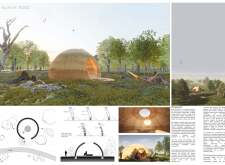5 key facts about this project
Functionally, the Earth Egg serves as a multipurpose space that can adapt to various community needs. It is a venue for artistic expression, a retreat for reflection, or a gathering point for educational programs focused on sustainability and environmental awareness. This flexibility enhances the project's relevance within its locale, allowing it to serve as a hub for interaction and learning within the community.
At its core, the Earth Egg is built on a philosophy that emphasizes harmony with nature. The exterior design features a façade made from earth-based materials, which not only lend the structure an organic appearance but also improve thermal performance. This choice reflects a commitment to reducing environmental impact while retaining aesthetic appeal. The layers of materials used provide a tactile experience that invites visitors to engage with the building on a sensory level.
The entrance to the Earth Egg is gracefully arched, creating an inviting threshold that encourages exploration. Inside, the central space is illuminated by two circular oculi that allow natural light to penetrate throughout the day, fostering an atmosphere that adjusts dynamically with the changing light. The interior also employs natural materials such as locally sourced wood, which contributes warmth and texture while supporting the building's overall ecological ethos. The result is a comfortable, inviting environment that seamlessly integrates the qualities of indoor and outdoor spaces.
One of the key design strategies of the Earth Egg is its emphasis on fluid spatial arrangements. The circular floor plan encourages movement and exploration, enabling users to engage with the space in various ways. This adaptability is intentional, designed to support activities ranging from workshops to exhibitions, reinforcing the project's role as a versatile community asset.
The relationship between the Earth Egg and its landscape has been carefully considered. Surrounding vegetation is integrated into the design, enhancing the sense of enclosure while grounding the structure within its natural context. This thoughtful positioning reinforces the project's mission of creating a dialogue between humanity and the environment, illustrating how architecture can nurture both community and ecological well-being.
What makes the Earth Egg distinctive is not just its form but its underlying philosophy centered on sustainability and connection. The use of local and natural materials, combined with a design that harmonizes with its surroundings, highlights a respectful and forward-thinking approach to architecture. The structure stands as a testament to how thoughtful design can meaningfully contribute to community engagement while prioritizing the health of the planet.
The Earth Egg is a project that invites deeper exploration of its architectural plans, sections, and design ideas. By examining these elements, readers can gain valuable insights into the creative processes and design principles that shaped the Earth Egg into a unique architectural statement. The project serves as an encouraging model of how architecture can respond to contemporary challenges while fostering community connection and environmental stewardship. For those interested in a closer look at the Earth Egg, exploring its architectural presentation will provide further details and inspiration on this innovative design approach.























